The Periodic Enemies Theme
The periodic enemies theme is about enemies that move in predictable, perpetual loops. This is not limited to literal loops; periodic enemies can move back and forth or up and down, as long as that movement is regular and repeating. The "period" of an enemy is the length of time it takes that enemy to complete one of these loops. Additionally, this definition includes "inanimate" enemies like fireballs and sharpened spikes, as long as they exhibit that predictable periodic behavior. The periodic enemies theme is, in a sense, like the inverse of the moving targets theme. Where the moving targets theme saw Mario aiming for cycling, patrolling and otherwise regularly moving platforms, this theme sees him aim away from cycling, patrolling, and otherwise regularly moving enemies. This makes sense inasmuch as the two themes are complementary. As this book notes many times, Super Mario World is a composite of the platforming and action genres, and this skill theme makes use of the action side of the timing idea. This is not to say that this theme completely abandons the platforming genre; a composite game never truly abandons either of its constituent genres. But the jumping in this theme is definitely downplayed, and this is reflected in a key stat. The periodic enemies theme has the lowest delta-height of any theme, which means that when jumps come in this theme, they're usually small. Like in the moving targets theme, this is because the jumps in this theme are about timing rather than momentum. (That this theme has the second lowest d-distance backs this up.) In this case, most of the key jumps in this theme are about avoiding the periodic movements of an enemy, and the jumps needed to do so rarely exceeds the height or width of a regular enemy, which is never that large. Much of the time a jump isn't necessary at all, and this is why the theme is in the action declension.
The periodic enemies theme is in the action declension not because there is a great deal of combat (as there is in the intercepts theme) but because the player is often forced to do the non-combat task common to action games: precise movement. Consider that Galaga, Golden Axe and Prince of Persia all have in common the need for the player to steer their avatar around enemy obstacles precisely. Even though combat is an option in those games�and indeed the most prominent option�the player's success also depends on evasion and timing. This is what the player has to do much of the time in the periodic enemies theme in Super Mario World. The theme isolates non-jump movement by use of terrain and the second-most important property of most periodic enemies.

The pathways above both make jumping more difficult than simply walking precisely. Both also feature periodic enemies that are invincible (the Ball�n�Chain). That invincibility is a key part of the periodic enemies theme in that it completely eliminates combat solutions. In the other themes, some kind of combat might improve the outcome of a given challenge, but in the periodic enemies theme this is less common because of the invincibility of most of the enemies. Given that, this is the theme with the least wiggle room, so to speak.
Most, but not all, of the periodic enemies levels are castle or fortress levels. For reasons explained in the levels themselves, we're going to ignore the two grating sections that occur because they're brief, poorly developed and more or less extraneous to the theme. Ignoring those, the iteration that takes place in this theme is remarkably well organized. Take a look at the illustrations of the first three levels, specifically paying attention to the way each new periodic enemy attacks.

The first castle introduces the smashing pillar, which is only dangerous in one direction. The second castle introduces fireballs and Whomps which are dangerous going both up and down, as well as Dry Bones which are dangerous in side-to-side patrols. Vanilla Fortress, the third periodic enemies level, introduces the Ball'n'Chain, which swings in dangerous circles. (Technically, the second castle introduces the Ball�n�Chain in a very simple challenge before the Whomps, fireballs and Dry Bones. But Whomps, fireballs and Dry Bones are all involved in an evolving cadence before the Ball�n�Chain, whose first use in a cadence is in Vanilla Fortress.) Each iterated periodic shape is a little bit more complex and more dangerous than the last. The fourth castle introduces the first accumulation, where up/down periodic enemies meet the down-only spiked ceiling.
After this, the game alternates introducing new challenge types and then including them in an accumulation. Forest of Illusion 2 introduces enemies on box-shaped paths, and Forest Fortress includes them in an (evolved) accumulation with both those box-shaped paths and one-directional smashers.

Chocolate Fortress likewise introduces the up/down spike obstacle, while the sixth castle evolves this obstacle and stacks it up with the box-shaped patrols from earlier.

In both of the accumulations, there's a clear evolution upon first the box-shaped patrol and then the up/down spike in the subsequent accumulation. This is the real source of the theme's most difficult moments, because the accumulated material never gets beyond two types of periodic enemy in a level at a time. Even in the pinnacle of the theme�even in the hardest single challenge in Valley Fortress�there are only two kinds of periodic enemies stacked up at once.

These accumulations are obvious, but not very "tall," if we're talking about how many accumulations are stacked in one level. That's not to say that this is a flaw; Valley Fortress is exactly as difficult as it needs to be. The central skill of this theme is timing, and when periodic enemies that move at two different speeds stack up, the player really has to be precise to nail the timing jump. We know that two enemies with two different periods can make for a great challenge, because that happens a lot in the accumulations of this theme. Would three heterogeneous periods have been too much for the player? It's hard to say, but it's not hard to imagine how the designers might have had a difficult time coordinating three periodic enemies. In any case, the two-period pinnacle challenges of this theme are so well executed that the absence of three-period challenges isn't detrimental to the game.
IGGY'S CASTLE
Because this theme begins in a Castle, there are no proper training-wheels challenges. The first level, however, is obviously a lot easier than it needs to be, even if it doesn't fit the mold of a training-wheels challenge. What makes this level easier (and centers it in the periodic enemies theme) is this grating that is placed all over the first section of the level.


This grating, which is one of the rarest features in the game (appearing only one other time), allows the player complete control over Mario's motion. All of the normal vector problems which might affect Mario on dry levels or in water are gone. While he climbs the mesh, Mario moves at the exact same speed in every direction--but only when the player wants him to do so. Gravity does not pull on him, nor does a balloon effect force him upwards. Even though there are Koopas climbing on the same mesh which theoretically can damage him, it's extremely easy to avoid them. It's a useful introduction to periodic enemies, however, in that many of these Koopas and the fireball you see above are looping periodically�with abnormally long periods. Rather than force the player to execute a timing jump through these enemies, the player can simply climb at a steady pace through the visible loop. The Koopas do a good job of emphasizing the action part of the level, but it's quite easy to defeat them. And of course, there is a penalty (either damage or the low-lying lava) that Mario could incur, but it's so unlikely that this is almost a training-wheels challenge throughout.
The second part of the level is much the same, teaching the player how to deal with periodic enemies while reducing the likelihood of real danger. The giant smashers that descend from the ceiling could damage Mario, but won�t often do so because the period is so long and the safe spots so obvious. It's more likely that the player would get caught under these than get hit by the Koopas of the previous section, but it's not that much more likely. The smashers, while not very slow once they start firing, have to cover a lot of distance before they actually reach Mario.

Like most of the large moving block-masses in the game, they also telegraph the dangerous part of their motion. In the end, however, they're just a typical example of the kind of periodic hazard that will inhabit many castles: an invulnerable source of damage on a quickly-repeating timer.
As a last bit of evidence that this level is actually trying to take it easy on the player, consider that it has essentially no evolution or expansion challenges. The nearest thing to either evolution or expansion is here, where the pit is between the smash-zone and the safe part of the level.

But as you can see, this isn't much of an evolution or expansion, since the gap is still small and bridged by a contracting platform. It does make for a short, quasi-crossover challenge since we have a moving target�but ultimately it�s so simple and avoidable that it doesn�t add much to the level.
MORTON'S CASTLE (FIRST SECTION)
The second castle begins with one of the most typical examples of the periodic enemies theme, although that theme does not carry the whole way through the level. Rather, this castle begins with periodic enemies and then ends with moving targets. This makes sense inasmuch as the two are complements and it's easy for the designers to slide from one to another. No skill theme ever completely abandons either of the composite genres. Every periodic enemies theme contains a little of the moving targets theme, and vice versa; that's part of what makes a composite game coherent. But let's take a look at the examples so we can see the specifics of what this means.
The goal of the first section of the castle is to focus the player on pure timing, eschewing even the timing jump in favor of a timing run. Invulnerability is a typical property of periodic enemies, especially in castles, and this one is no exception; the Thwomps and Ball�n�Chain enemies are all un-fightable because of their invulnerability. There's another property which appears here which is a little more complicated: when dealing with periodic enemies, it's often easier not to jump. The beginning of this castle is a great example of how this can be so.
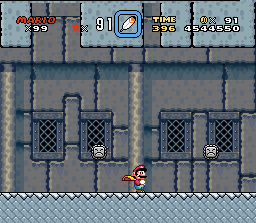
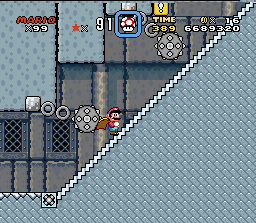
Seeing these Thwimps, it's easy for the player to simply react, thinking the level is in the preservation of momentum/or intercepts theme. Doing so will cause Mario to take damage most of the time. The arc of this enemy�s movement cuts across Mario's forward jump arc in an uncommonly direct way, and these enemies also move up and down through the air much faster than Mario can jump. (Remember to ignore everything you know about physics.) Back-jumping and cape gliding simply will not do. Instead, the best thing the player can do is simply time the jump of the Thwimps and have Mario walk through them. The same goes for the Ball�n�Chains that follow; the escalator stairs might trick the player into thinking that it's time to ramp up Mario's momentum, but it isn't so. Jumping is mostly out of the question; thanks to the angle of the ramp, Mario would have to squeeze through a space only one or two blocks wide. This is timing at its purest, with as little jumping as possible. One might object and say that this isn't really an action declension because there's no action. I think that there is action; there's just no killing. Plenty of action games have sections where survival alone is the concern�this is what separates them from being in the hack-and-slash, brawler or shooter subcategories. Super Mario World does not have elements of those games, but it has all the hallmarks of the action genre, both in combat and out of it.
The second section starts moving back toward the platforming declension, but sticks with the focus on periodic enemies. The Thwomps are the best example of this, certainly.
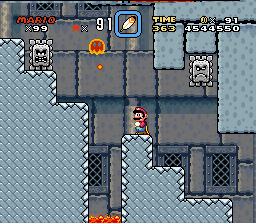
Notice that Mario is jumping, and the player has to use precise timing, but it's not quite a platforming challenge. Mario is going under the Thwomps (and even possibly the fireball), not above them. Fast-reaction jumping or long distance-jumps are not the best way to survive this gauntlet; small jumps and well-timed runs are. Just as before, this section is another typical example of the kind of action we'll see throughout the periodic enemies theme. And, just as before, there aren't yet many evolutions, or expansions--although their time is coming.
One last note about the level: most of the Dry Bones platforms are crossovers that split the difference between the periodic enemies and moving targets themes. (You may recall this being noted in the relevant section in moving targets.) It's worth noting again, however, because of the context and focus this section has on the periodicity of enemies. The Dry Bones patrol the superior platforms at several locations.
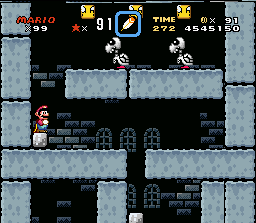
In each case the relevant timing jump is easy, and the real focus is on dealing with the enemies�in other words, action tasks. That's pretty self-explanatory, but there's one additional property of the Dry Bones that's interesting: they revive. Although it's possible to permanently defeat the Dry Bones with the cape, doing so with a jump will cause them to simply get back up again after a few seconds. This is yet another periodic property, unique to this enemy.
VANILLA FORTRESS
Vanilla Fortress, the only water-based castle level, is full of delightful challenges, from a game designer�s point of view. From the perspective of a player, however, these challenges are perhaps a bit annoying because of all the waiting, slow movement and lack of proper jump physics. What the designer loves, but the player probably doesn�t sense, is the elegance of these challenges. Consider the first stretch in which the player has to steer Mario through a gauntlet of swinging maces, through which we have these Fishbones swimming:
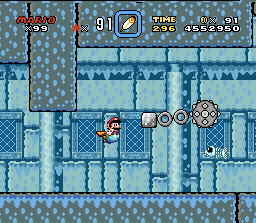

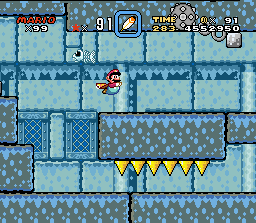
This is a wonderful example of a mutation challenge, one of the best in the game, because it captures exactly what a mutation challenge is about. In every case here, Mario is facing one swinging mace and one undead fish, but their relative positions are different. The images above show how Mario�s movements change slightly�always in a different direction through a differently sized space. Neither the size nor the complexity of the challenges change, but the feel of these challenges do. Because of the odd way that swimming works, swimming upwards to shoot the gap between the mace-head and the fish (as you see in the first screenshot) is a different skill than controlling Mario�s plummet to the right height (as you see in the second). Each challenge is a standard challenge, and yet completing them is meaningfully different, in terms of player skills. What makes it even sweeter�again, from a design perspective�is that it totally fits within the periodic enemies framework. These challenges are all about moving steadily and deliberately, with a focus on the right timing.
The other point of excellence in this level is how nicely it begins the player�s training in the way of controlled-height jumps. Water levels are generally the game�s most widespread problem, but they do accomplish one thing well, and that is to teach one of the game�s most difficult skills. The controlled-height jump is any difficult jump in which Mario has to go below his maximum possible height, or else face a serious risk of damage. Players are very much habituated to maximum height jumps, as it allows the most time for adjustments before landing, and doesn�t require precise controller skills. There are many controlled-height jumps to come in Valley of Bowser and the Special zone, but the training begins here.
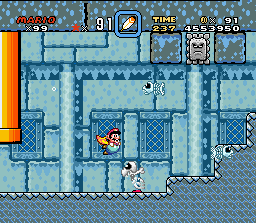
You can see in this evolution/expansion how Mario has to carefully thread his way through enemies that can all move fast, relative to his own swimming. The Dry Bones and Fishbones both force Mario to move, but gaining height isn�t an option because of the speed of the Thwomp he must eventually pass.
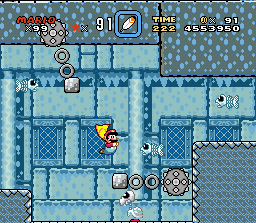
The pinnacle challenge for the level is this evolution/expansion which combines most of the level�s contents into one dangerous cluster. The near-overlap of the two Ball�n�Chains means that Mario will have to shoot through the challenge rapidly, or else lose the window of safety. The other enemies and terrain greatly narrow the path that�s available during that limited window, forcing Mario�s swim motions to be very tight on the vertical axis. This tight vertical motion is not particularly hard when done in the water, but it does show the player�s motor skills how a controlled-height jump might be done through shorter presses of the jump button.
LEMMY'S CASTLE
Lemmy's Castle is firmly in the periodic enemies theme, but it doesn't look like it is. Placement in a skill theme is determined by what skills the player has to use, and not by appearances. Most of the time, a challenge�s appearance will show the player what skills will be necessary, but this is a case where they don't. The first section resembles something that might come out of the intercepts theme, when Magikoopa appears and starts flinging bolts at Mario. The important thing to notice, however, is that after Magikoopa's first appearance on the same level as Mario, his placement makes a huge difference.
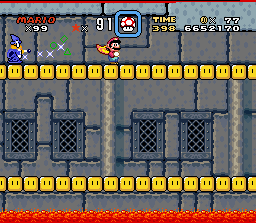

Magikoopa's ostensible purpose here is to fire a bolt that will open up a path downwards. He alternates between top and bottom, and thus has a reduced chance to actually hit Mario instead of the spinning blocks. What the player has to do here is simply walk Mario to the right spot and wait so that Magikoopa's bolt opens a path over a safe place rather than over one of the d-distance gaps or fireballs. Walking to the right spot and waiting is, as we have seen, the defining skill of the periodic enemies theme.
While there are rules governing Magikoopa's appearances that help Mario get down from the high platform, his locations aren't exactly fixed there or throughout the rest of the level. As such, it's hard to divide the first half of the level into proper challenges. There are obviously three sections to the first half, the section already seen, and the water and lava sections below.
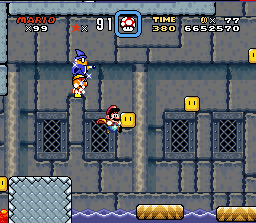
This section is merely a mutation that declines harder toward action, by making it possible for Magikoopa to hit Mario with either the projectile or the enemy it spawns when hitting one of the blocks. Standing in the right place is still operative because Magikoopa aims at Mario, but because of the watery platforms there's more emphasis on speed. This could be called a movement towards the preservation of momentum theme (an odd crossover) because of how this section goads the player on. Most of this, though, is just a product of the rare Magikoopa, who himself bridges across themes bizarrely.
The second half of the level shows us that the designers were indeed working with the idea of inversion. Here we see the platform as a kind of periodic enemy itself. Several sections of this second half lack enemies but feature vast amounts of lava and wide platforms.
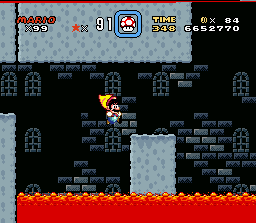
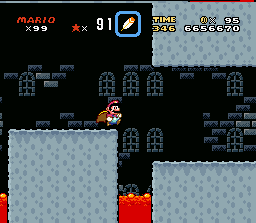
A moving targets level would probably have used narrower platforms, shorter waiting periods and more necessary jumps. As it stands, many of these challenges can be completed with one jump and a lot of walking. The idea here is that the lava is the periodic enemy, but the idea is inverted. Instead of waiting for the lava to recede, the player has to wait for the platform to come out of it. It�s still the kind of relatively long wait characteristic of a periodic enemies level, as are the straightforward and obvious jumps.
That�s not the only element in the second half, however; there are also numerous Dry Bones and fireballs cast into periodic roles. Many of the challenges featuring these enemies display inverted forms as well. The first enemies Mario encounters are a fireball and a Dry Bones that patrols the platform beyond. Mario has to time the jump between these enemies and land�a challenge which evolves twice.
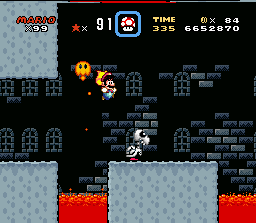
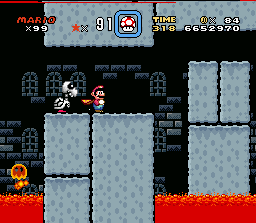
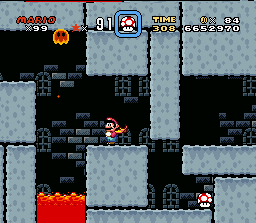
In the first evolution, Mario has to do this while jumping upwards, which is an evolution; in the second he descends, which is an inversion (mutation) of that previous jump. The same inversion technique happens again later in the level with another challenge involving two Dry Bones.
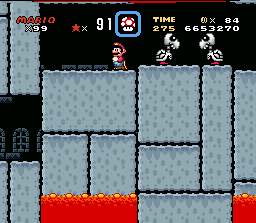
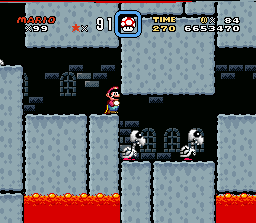
Again, ascent followed by descent. The only real problem is timing the periods of the enemies, so the inversions are mutations rather than evolutions. Because the key skill is timing the enemies rather than the platforms, though, the descending jumps are not easier than their ascending counterparts as descending jumps normally are. Instead, these are equal mutations in which the designers played with the idea of literal and abstract inversions of typical periodic enemies ideas.
LUDWIG'S CASTLE
Ludwig's castle is similar to Vanilla Fortress in the purity of its theme. Aside from a few pointed intercepts, the entire castle (until the boss, at least) is made up of periodic enemy challenges. This level is also interesting because of the concentration and concatenation of those challenges. For instance, the player has seen Ball�n�Chain gauntlets several times before this point, but there's no gauntlet in the game quite as long as this one.
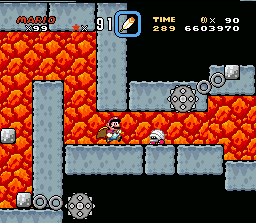
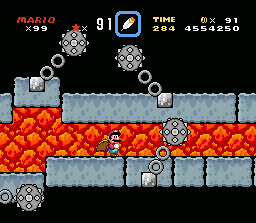
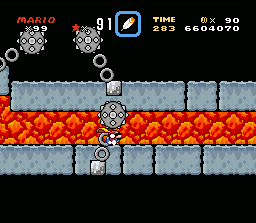
At more than 20 blocks in length, this is the longest ground-based challenge in the game. (There are some longer challenges that involve cape flight.) There is no reliable safe spot in the gauntlet, and there are several places where the player's skills will be stretched. On the right, above, you can see a spot where Mario is forced by the timing of the maces to run and duck. Now, this "slide" technique had been around since the first Super Mario game, and it is very intuitive, but this challenge gauntlet still represents a kind of idiosyncratic peak in the periodic enemies theme. Not only must the player not try a jump, but they have to do the opposite of jumping.
Next there is a surprising evolution of the ceiling-mounted smashers from the first castle. In this case, the entire ceiling is on a periodic timer that can be reset by a switch in the middle of the area. Without hitting this switch, Mario will be crushed�and there's not much leeway time in getting there. The trick is that going too fast (especially with the cape) will cause Mario to be hurt and probably lose a life because of these fireballs.
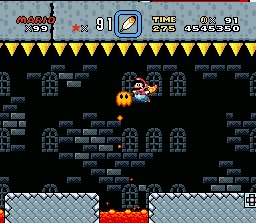
Full momentum is possible�and it's even easy, because of the conveyor-belt stairs�but it's risky because Mario can easily careen into these fireballs. Avoiding them would involve either some expert anticipation and cape-gliding, or a series of controlled-height jumps. A new player's best bet is to simply wait at the edge of each pit. Obviously, each "wait" is little more than a hesitation, but it's still a skill that is idiosyncratic to the periodic enemies theme.
There are a couple of other noteworthy features in this room. The most obvious is the switch which controls the ceiling. Once the player hits this switch, the period of the ceiling is reset and Mario has a limited time to reach the end of the room. To enhance the tension, the second half of the pit-jump challenges are actually an inversion of the fireball challenges the player has just completed. Now, the player has to break momentum to avoid a slow-moving enemy and a 1-block lip just a bit before the pit's edge.
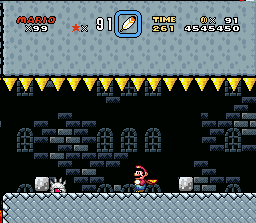
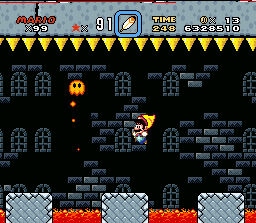
The last section of the castle is another example of this level's strict adherence to the periodic enemies theme. The Koopas all move in repeating loops along the only other fence-grating section in the game, the first being in the first castle. Unfortunately, there's virtually nothing interesting to say about this section; the climbable grating is a break from typical platforming, but not one that sees any interesting development.
FOREST OF ILLUSION 2
Forest of Illusion 2 gives us another water level in the periodic enemies theme. If you have read the intercepts theme, you know that most of the water levels are intercept-based. For the most part, this is because the intercept theme fits water so well. So although this level is definitely in the periodic enemies theme, it declines irregularly toward the intercepts theme. This is actually a useful object lesson. The designers could have invented three new kinds of enemy instead of just one, or added some new mechanic to this level. They chose not to do so. A common problem I notice with young designers is the tendency to design a completely new enemy or environmental feature every time they want to add to a level. This, of course, leads to a lot of design problems and a bloated schedule. Here we see Super Mario World�s designers diverge from an established pattern because it makes practical sense. (But remember, it�s only a pattern and not a rule.) The intercept elements in this level work well enough, and sometimes quite well. In short, the lesson here is to not overdesign, no matter the reason. The main feature of the level is the Urchin, a slow-moving and nearly indestructible enemy that has one of the game�s hardest hitboxes. Most of the early narrow challenges will show the player just how little leeway Mario will have when trying to squeeze through.
The standard challenge consists of a couple of patrolling Urchins. The next challenge gives us a simple evolution: a wave of water-specific intercepts in this wall of Blurps that come at Mario.
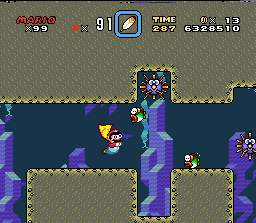
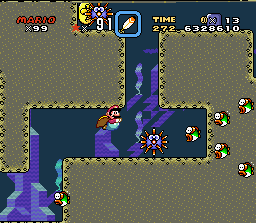
With a cape or fire-flower, there�s nothing especially hard about these guys because they�re so slow. That said, the period of the Urchin and the shape of oncoming Blurps both force Mario to slow down. Effectively, this is a signal to the player to start using a periodic enemy mindset and skills instead of rushing, and it�s an important signal because this is a fairly slow level.
The next significant challenge is the introduction of looping Urchins, a straightforward evolution of the standard Urchin challenge. These looping Urchins always come in groups of more than one, so as to make their overlapping periods a greater challenge. Or, at least, that is the idea the designers seemed to have toyed with. The second challenge below is actually from later in the level, but is a direct expansion of the first rotating Urchin challenge.

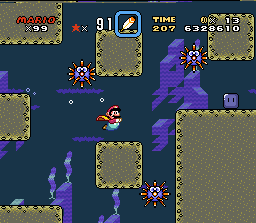
The pattern is fairly obvious: after the introduction to looping Urchins, there is a simple expansion challenge that features three Urchins rather than two. Later in the level we have an evolution that features only a single Urchin, but a greater number of intercepts and includes the much more dangerous Rip Van Fish. Either because the Urchin is too slow, or because the aggro radius on the Rip Van Fishes is too small, all the rotating Urchin challenges are just a little bit too easy and too slow for this point in the game. Yes, the point of the periodic enemies theme is to go slow, but at this point in the game a little more difficulty seems natural.
Now, getting back to chronological order, we see here an evolution challenge that fits the theme but which uses different enemies. Throughout most of this level, the player is able to land Mario on a safe, stable surface while waiting for the Urchins to cycle. The substitution of patrolling fish for Urchins here means that this is really not possible, because the fish move so fast that the player either has to blow through all three patrols at once (which is somewhat tricky considering the player can't really see the top and the patrols are short) or tread water between them while waiting.
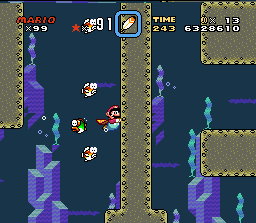
This would have made for a great b-section evolution later, in which the player has to do some serious water treading in between large groups of patrolling Urchins or other enemies, but this doesn't really happen. This is another case of this level not doing too much with the Urchins. Perhaps the designers felt they hadn't given the player enough time to get used to them, but it�s impossible to know now.
The closest thing to a direct evolution here is this intersection of several Urchins later in the level. The patrols of these Urchins are cut progressively shorter so that the player has to shoot Mario through much more quickly than before. This is particularly problematic for the last Urchin, which requires that Mario plunge downwards.
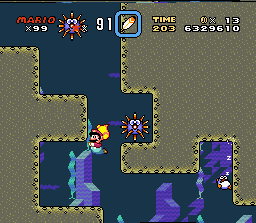
A hard sinking motion is one of the most counterintuitive in the game, because it�s impossible in dry levels (you�re either falling at full speed or cape speed, nothing in between). In a water level, though, holding the down button on the directional pad will cause Mario to sink with controllable speed, so it�s not technically hard. This isn�t the first time the player has had to use this skill, but it�s the first time that Mario has had to drop through a periodic enemy patrol into unseen territory. Mechanically, it�s like everything in this level: a little bit easy for this point in the game. Psychologically, on the other hand, it�s an interesting way of making the player uncomfortable by doing something unfamiliar into an area that is unseen.
If you believe in that sort of psychological setup as a function of design, then that plunge works well as a setup into the final challenge of the level. Here we see the big crossover into the intercepts theme, as the player is confronted with the rare Alerting Chuck, who summons a swarm of Rip Van Fishes. The essential aspect of the Rip Van Fish, as we have noted, is that it�s faster than Mario when travelling laterally. The mitigating aspect is that it cannot travel in a perfectly horizontal line, and will overshoot Mario on the X axis very often. Because of this, the designers were canny about the difficulty, putting almost all the intercepts above Mario instead of dividing them evenly between above and below.
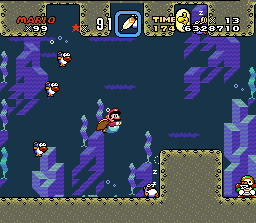
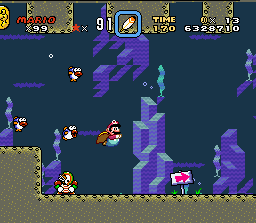
Because of the programmed paths of the RVFs, this gauntlet is much less difficult than it seems. Had half of these fish been located below Mario, the crisscross patterns would have been very dangerous, but because only a couple of them were below, Mario can sink to avoid the bigger swarm above him as he approaches the end-gate. This is another example of some clever player psychology: this gauntslet isn�t actually that dangerous although it feels so. By simply doing what a player would naturally do (shying away from danger), Mario will be able to get to the gate with relative ease�but the excitement of this challenge is still so palpable that it remains fun.
FOREST FORTRESS
What makes Forest Fortress interesting is its flaws, rather than its successes. This isn�t to say that it�s a bad level. A bad level would be one that is never fun, and this isn�t the case with Forest Fortress. Indeed, Forest Fortress has a number of really fun features tucked into the back end of it; it�s just that all the hard parts come at the beginning. The problem comes from the fact that the looping, tracked saws of this fortress are fundamentally flawed in their design.
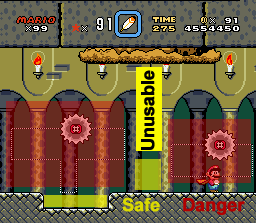
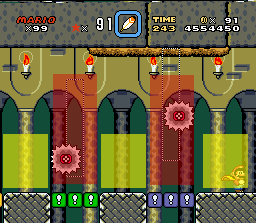
When these saws are tracked along a mostly horizontal path, they are quite difficult for new players. First, the saws are big and therefore harder to avoid, their hit-box is unforgiving, and they deal damage on all sides. Secondly, the saws move more quickly than most enemies, meaning that it�s harder for a player to adapt to the proper timing, and harder still to simply react. Third, the saws spend a lot of time in range of Mario, meaning that simply �walking out� of the danger zone is more difficult�most of the safe spots are only one block wide. (Interestingly, though, this is one of the purest examples of the walk-don�t-jump aspect of the periodic enemies theme. Jumping will almost always earn Mario a saw to the torso, whereas merely walking with good timing will leave him safe.) Compounding all of these difficulties is the fact that the level scrolls at a set rate, trapping the player in range of these saws. And there are ceiling-smashers that reduce the amount of safe space in each challenge even further.
The reason why this is structurally bad is that these lateral saws (pictured above, left) are the absolute hardest part of the whole level, and they come first. Once the saws switch to vertical tracks (pictured above, right), they�re hardly difficult at all. Even if the player has been negligent in completing the switch palaces, the path of these saws takes them far away from the player, and the length of that path means that the period is long enough for even newbies to take advantage of it with an easy jump. Because of this discrepancy, the second half of the first section is much easier than the first. Indeed, just about everything in the level is much easier than the first section, but these jumps especially. If this seems inappropriate based on what you might know about how levels in Super Mario World have progressed, it is. The hardest part of a level should not come first; that�s just bad pacing, no matter which game you�re playing/designing. I don�t think the design team intended the first part of the level to be the hardest, however. It�s just that tracked saws have a major inbuilt flaw, but they were used anyway.
The second section of the level has a much better structure than the first section. In the first section of the level, the player had to face a series of tracked saws that were much more difficult than they looked. The cognitive dissonance in that is very frustrating. The reverse happens in the second section, though: the level looks harder than it is. There is only one really taxing challenge, which is this pit full of saws.
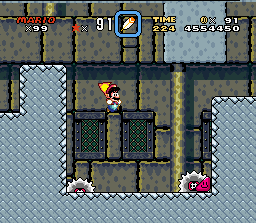
Because of the long descent, it can be difficult to nail the timing on this jump and land without taking damage. The effective landing area is reduced because Mario has to land with room to run, so as to take advantage of the wall-running bumper corner. This is actually one of the only truly challenging descents in the game; most of the game�s hardest challenges are lateral or ascending. The rest of the level is principally lateral, and not very difficult. The gap jumps on the right, below, are really not that difficult. Although the platforms are as small as they could possibly be, there�s a floor below. Obviously, there are three saws that patrol that floor, but the floor is so big that the saws are only dangerous once in a while. The fireballs are not much of a threat either; much like we just saw at the end of the descending ceiling room in Ludwig�s castle, these Fireballs are cued well in advance of Mario�s jump. Most of the time, the Fireball will be descending by the time Mario needs to jump. If the player has the cape powerup, these jumps are quite easy. Even if the player doesn�t have the cape, this section is only a trio of saws away from being a training-wheels challenge, even if it feels harder.
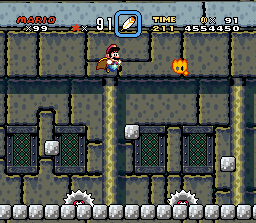
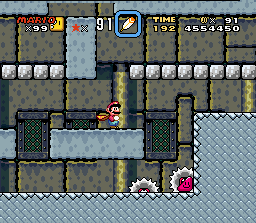
That said, these are not really indictments of this kind of level design. A level that seems harder than it really is can cause the player to experience the feeling of dominance and skillfulness. Videogames are often great because they can make players feel like their successes are much greater than they really are; this is a good example of the practice, achieved purely through design.
Finally, there are just a couple of other things worth mentioning. The last few challenges in the castle are yet another example of how the designer makes the player feel more accomplished than he or she really is. The first time the player sees this ledge, he or she will probably rush forward to preserve enough lateral momentum to negate the low ceiling.
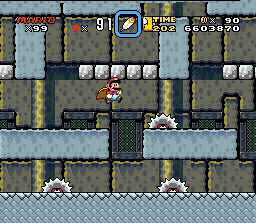
This will lead Mario straight into an oncoming saw blade. This process repeats, though, and for the next gap, the player will know the blade is coming, and wait. This is actually an important moment for the player: in anticipating the oncoming saw blade, they�ve been forced to consciously recognize one of the fundamental aspects of the skill theme they�re in. Knowing when to stop and wait is the bedrock upon which the periodic enemies theme is built�even if these saws look a little bit like intercepts. With any luck, the player will begin to get an intuitive sense of when enemies are going to appear.
As a last note, I�d like to point out the massive optional challenge at the end of the level. With the cape, the player can fly over the game�s widest lava pit, over more than a dozen fireballs, to a bonus door surrounded by 1-up mushrooms.
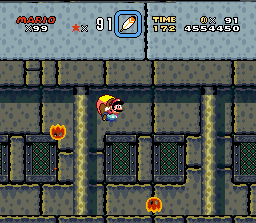
This kind of �feat of strength� challenge is a nice touch, when it�s optional. It does show that at some point, the designers must have become aware of how game-breaking the ability for sustained flight could be.
CHOCOLATE FORTRESS
Chocolate Fortress is a neat level, in a literal sense. That is, most of the challenges in the level are clearly defined and fit neatly into obvious classifications. Chocolate Fortress is really quite repetitive, and yet still fun, because the iteration of ideas in the challenges are done insightfully. What the designers set out to do is to use the same game design idea (but with small variations) over and over until they reached the limits of what was fun, before starting over with a new idea and doing the same thing. Thus, the level is divided into two clear sections that each take one idea and push its permutations to the brink of annoyance, and this makes up all of the level�s content. The reason this succeeds, however, is that the designers are very strategic in how they iterate and for how long.
The first idea at work in the level is the pointed stick obstacle, which is introduced immediately. They work in more than one way, either in a pinching motion or moving in parallel. This is the standard challenge, and it will be contorted in every conceivable way.
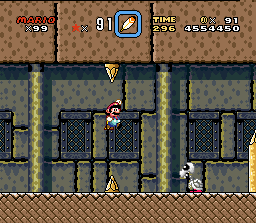
Immediately the level commences with a series of evolutions. As you can see on the right, Mario has to now make an ascending jump into a narrow aperture to get through the trap. The next jump adds an instant-death pit and a patrolling enemy on a small platform. (There was a patrolling enemy in the standard challenge, but he was easily avoided; not so in this case.) And then every challenge after that includes some amount of these procedurally-shot fireballs which come in slightly different patterns every time throughout the level.
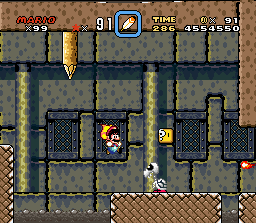
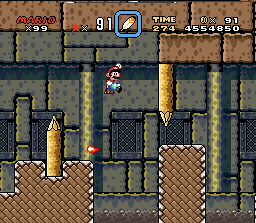
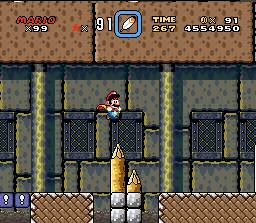
These fireballs represent the last evolution the level can bear before it has to change the standard challenge to something new. This level has been about adding evolution after evolution, and it works in that these slow-moving sharpened sticks are much more fun to overcome when there are enemies and fireballs and different kinds of terrain involved. But there is a limit to complexity a level will bear before it starts to be annoying rather than fun, and when a level reaches that point, it�s time for it to do something different. The designer has three options within the framework of a composite 2D platformer: use expansions, use mutations, or establish a new standard challenge. Interestingly, the designers here avoided expansions and went with mutations.
The sharpened logs are all about the same size, give or take one block, and the pit jumps actually get smaller after the first one. (My opinion is that the designers were saving expansions for Valley Fortress, which is a very similar level that does use expansions, and they are more difficult.) Instead, what you see are simply mutations: challenges that simply re-arrange the same elements to create challenges of equivalent difficulty, but which require slightly different approaches.
In the second half of the level, the designers instituted a new standard challenge: the overhead Thwomp. If anything, this is an even purer example of adherence to formula. After the first Thwomp (which is actually irregular) you can see how the evolutions and expansions take place.
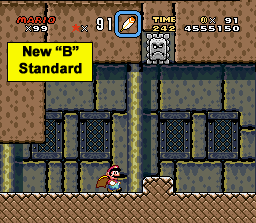
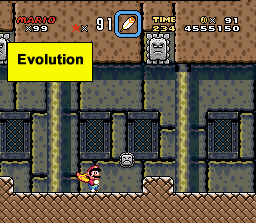
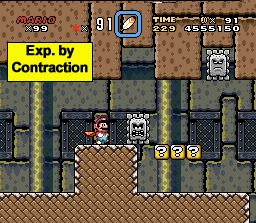
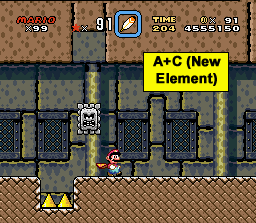
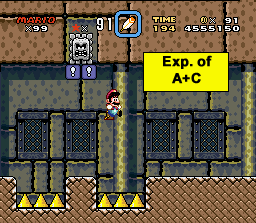
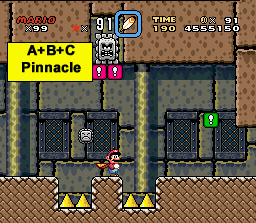
(There are actually several other challenges besides these 6, but the pattern is clear)
The pictures more or less explain themselves, but one thing that isn�t really captured in the images is the amount of space between each one of these challenges. In most levels, the challenges have components that spill over into other challenges, or directly abut one another. With one exception (the four Whomps), this is not the case here. Every challenge is set up so that the player can stop, wait, observe the timing of the periodic enemies involved, and then choose the correct path. This is by far the rawest, most exposed example of the periodic enemies theme in the game. And yet each challenge is slightly different, whether because of an evolution, expansion or mutation. This is elegance in game design, occurring before our very eyes.
WENDY'S CASTLE
Whereas Chocolate Fortress was an exercise in brute force�the same idea pounded into dozens of shapes until it wears out�Wendy�s Castle is an exercise in mounting tension. The level carefully stacks one element on top of another, building towards its hardest challenges. Wendy�s Castle relies on evolutions and expansions in such a way that it never needs mutations. Mutations, if they are appropriately difficult, give a player the feeling of dominance, and that�s psychologically necessary for most players some of the time. But in building a level that doesn�t use mutation challenges, Wendy�s Castle actually gets right everything that Forest Fortress got wrong. The tracked saws in Forest Fortress were badly structured so that their hardest iterations came first with no time for the player to warm up. This time around, the level is structured perfectly so that every challenge builds on the last in a way that prepares the player for what�s coming, while still presenting an increasing challenge.
The basic idea behind the level is that it takes the sharpened logs of Chocolate Fortress and combines them with the deadly saws of Forest Fortress. There are, naturally, some important differences. The sharpened logs have evolved into these giant smashing pillars. The behavior is mostly the same�it�s still a periodically stabbing stick�but the size and speed of the attacks have both gone up, and now the entire object causes damage. Forest Fortress had done something similar when it evolved the Urchin into the saw enemy, and then combined it with the overhead smasher.
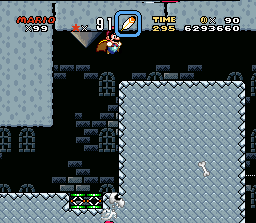

Why the first challenge must involve a springboard jump I cannot say for certain. It may be that the designers wanted to show that the giant smashing pillars will always cover the entire screen when extended; that�s valuable data. I�m not sure a regular jump in an empty room wouldn�t have conveyed it just the same, but springboards are fun every once in a while, so it�s not like this is a flaw. Immediately after the first smashing spike pylon the level throws a couple of tracked saws at Mario, but you can see how easy they are. This is just a warm-up.
From there, the designers employed the obvious evolution: combine the two elements they�ve introduced so far into one challenge. They do it right, however, in putting the vertically-tracked saws first, since they�re the easier challenge, thus building the tension gradually.
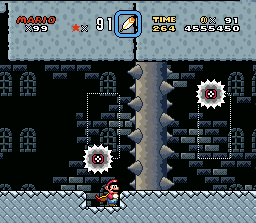
For challenges two and three, the designer�s technique couldn�t be clearer. It�s a simple expansion: the number of saws goes up and the space between smashing spike pillars goes down. Even though all three of these challenges are smashed together, the pacing still works well, because the player has to move through these challenges so (relatively) slowly.
The subsequent challenge is the pinnacle of the mounting tension. It�s a little less obvious, but still consistent with what has come before. The smashing pillars are gone, but the player now has to steer Mario through a series of difficult jumps. The expansion which started two challenges ago reaches its highest point, as there are three saws whose paths the player has to navigate without getting hit and/or falling to the floor.
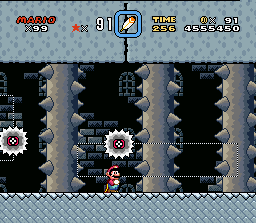
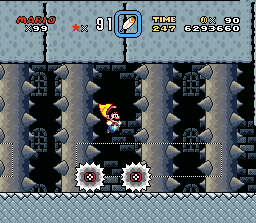
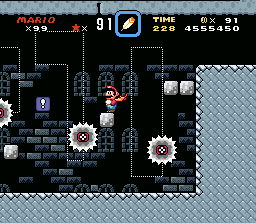
Additionally, if we think of the �safe spots� between the smashers as landing points, this last challenge is an expansion upon that dimension, too. Each safe spot was at least two blocks wide, but each platform here is only one block wide�and even though the fall isn�t fatal, players will quickly become aware of how narrow a landing it is.
The second part of the level is different in substance, although very similar in structure. It�s also a really good example of how a series of expansion challenges ought to be done. Here we see something that levels in the periodic enemies theme rarely do: decline toward the complement theme. The many moving platforms in this section are supposed to be a refreshing break from the small, halting walks of the rest of the level, and they do a good job. They�re also structured beautifully.
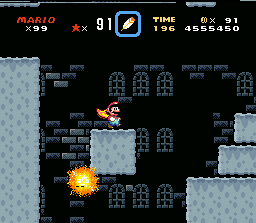
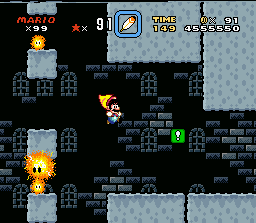
What�s happening here is that the challenges are going through progressive expansions, but in more than one way. One-dimensional expansions (e.g. a pit jump getting wider and wider) are fairly boring in sequence, but Super Mario World rarely does this. Instead, more than one element is expanded across the whole section. Also, in this case these elements alternate, first expanding the number of Hotheads, and then expanding the number of platforms. The first two challenges feature one periodic enemy and one moving platform. The second challenge features two moving enemies and one moving platform. The third proper challenge features two moving enemies, and two moving platforms. The last features three enemies orbiting three platforms (although they�re not of the moving variety). Rather than simply increase every element in every iteration, the designers expand the number of enemies, and then the number of platforms, back and forth.
The last thing I�d like to mention is the two de-evolutions that are part of this level. Both of these challenges are expansions that drop an evolved element. Here they are again, side by side.
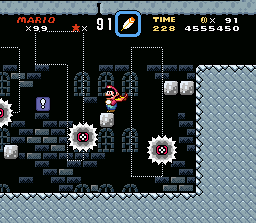
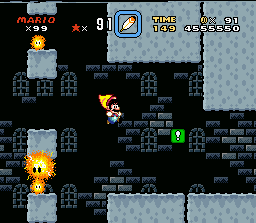
What I mean here is that the three saws challenge expands the number of saws but subtracts the smashing pillars, and the Hothead challenge increases the number of enemies, but removes the motion of the platforms. Essentially what the designers have realized is that if you expand to a certain point, some of the evolutions have to come out or the challenge will be too difficult. This seems to suggest that the design team was somewhat cognizant of their expansion/evolution strategies. Obviously, they wanted to use successive increases in numerical difficulty, because that would present the most coherent level. When they realized those increases might be too hard, they didn�t break their pattern; they simply figured a way around the problem that kept their ideas in order.
VALLEY OF BOWSER 2 (MIDDLE SECTION)
For the first part of Valley of Bowser 2, see the intercepts theme; that part of the level makes for an interesting point of comparison between the preservation of momentum and intercepts themes. This part of the level is an example of the periodic enemies theme, however, and one that deserves attention because of how badly executed it is.
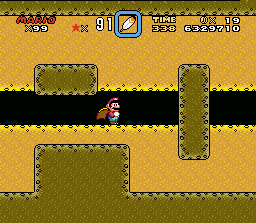
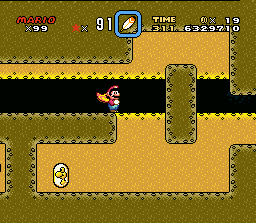
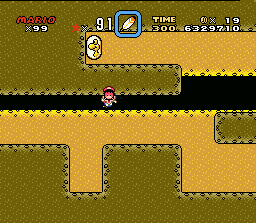
The idea behind this part of the level is clever: what if the level itself could be the periodic enemy? What if the path could be the obstacle? And it certainly has most of the qualities of a periodic enemy: it is invincible and it has a clearly timed behavior that it follows. Most importantly it involves lots of waiting and walking, and it diminishes the value of jumping. The problem is that it does this to such an extreme degree that it�s hardly any fun. If Mario gets trapped between the moving pathway and a wall, he will die instantly, so the penalty is 2 at all times�a rare thing in the theme. This wouldn�t be too bad, considering that this is one of the final levels, but there are some blind pathways that are completely inappropriate in this context, which you can see below.
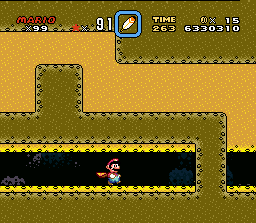
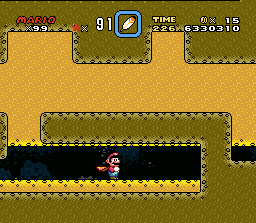
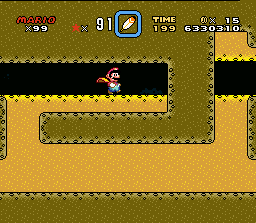
These pathways extend off-screen in such a way that if the player attempts them at the wrong time, Mario will be hopelessly trapped. The problem is that the player cannot know these runs are impossible the first time through�Mario has to die in order figure this out. Obligatory deaths are almost always a bad idea. I have written about this elsewhere, but many game designers report that one of their most useful metrics for playtesting is the question �whose fault was this death?� If the players consistently feel that it wasn�t their fault, that the difficulty was �cheap,� then designers will often change a challenge�s content. Shigeru Miyamoto and his team are normally virtuosic in their ability to avoid these kinds of deaths; players may lose lives while playing a level, but not because they weren�t psychic. To see this level and its blind alleys seems a little bit strange.
This section could have been remedied in a couple of ways that seem obvious. (Admittedly, I say this with the advantage of 23 years of hindsight, but lessons are lessons.) The first way was to simply remove these dead ends, or give some greater reward for getting in and out so that the player isn�t dying for absolutely nothing. These sections are so drudgingly slow that having to replay them is un-fun, when fun was supposed to be the goal. Another remedy would have been to simply break this corridor up into two or three sections. It depends how you count them, but there are at least six separate runs and four whole-period waits in this section�without any break. It would have been easy to divide this in half, and have a crossover challenge or something to break up the monotony in the middle. Monotony and frustration may have a place in the grand scheme of game design, but not in this game.
SODA LAKE
Soda Lake is a frustrating level for mostly the same reasons that Tubular (examined later) is a frustrating level, although there are significant differences between the two levels that make Soda Lake fair, and Tubular unfair. Tubular is unfair because it takes away all the skills players have been preparing up to that point, and requires skills they cannot adequately prepare except by dying on that level over and over. Soda Lake is only half-guilty of this crime, because the player is adequately prepared for water levels and swimming tricks, but not for the central enemy found here. The Torpedo Ted is a problematic enemy; some of the problems are rooted at the mechanical level. In the introduction I noted that it�s exceptionally uncommon for an enemy to occupy a space not perfectly divisible into coin-block sizes. There are enemies who move through spaces that are not on a perfect block-sized grid, but not really any that travel in straight lines while occupying a non-integer amount of space. The Torpedo Ted, however, does cut across these non-integer spaces in a meaningful way. Additionally, most of the enemies in the game have either an accurate or generous hitbox. The Torpedo Ted has a relatively egregious hitbox problem, especially on the front and back ends. Mario can easily take damage when not seeming to touch him. The final problem is that the Torpedo Ted doesn�t travel at a uniform speed, unlike almost every other enemy in the game. In the end, though, the player can adapt to these problems, because unlike in Tubular, the penalty for getting hit isn�t always instant death.
The defining features of the Torpedo Ted, the ones that make this a periodic enemies level, are its invulnerability and unlimited quantity. Torpedo Teds cannot be damaged in any way available to the player in the level, and they will keep emerging on a predictable timer. This is not to say that the theme isn�t easily confused for the intercepts theme, or even the perseveration of momentum theme. The Torpedo Teds can seem to somehow gain ground on Mario all of a sudden and force a reaction. Moreover, at certain points it�s easier to swim as fast as possible through the challenges before the screen can get cluttered. Ultimately, though, the toughest challenges of the level require the slow, controlled, precise movements that we have come to expect from the periodic enemies theme, and all the challenges in the level can be solved with the periodic enemies set of strategies. The standard challenge for this level is one launcher accompanied by a scattered group of Blurps. The number of variables in the level is actually fairly small, so we can see the evolutions and expansions clearly. For example, we see a fairly simple expansion challenge as the second challenge.
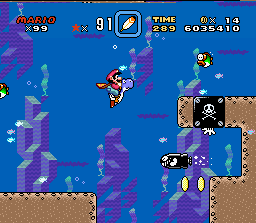
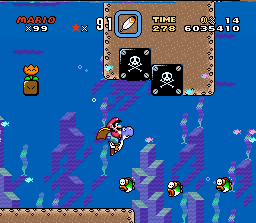
Here the number of torpedo launchers goes up while the number of intercepts stays the same, but those intercepts are structured so that the safe path is contracted a bit, adding to the challenge. Next we see challenge number two in an evolved form, with the launchers bisecting the passable portion of the level:

It�s next to impossible to squeeze through the upper path because of the hard hitbox on the torpedo and the rapid period of the launcher. This is one of the examples of how this level can be a bit unfair, because the challenge asks players to make a quick judgment on an irregular enemy they�ve never seen before. The lower path is less perilous than it seems, though, and gives the player a good idea of how low Mario is expected to go in later challenges.
In the next challenge (a simple expansion via increased launchers and Blurps), the design team had to tune down the difficulty by adjusting some enemy properties specifically. In the first three challenges, each battery of launchers would start firing as soon as Mario was in range of the front-most launcher, and usually at a distance of 4+ blocks. This battery of launchers, whether because of spacing or custom enemy scripts, will not fire as one, and will only start firing when Mario is nearly right on top of them. Because of this reduced aggro radius, it�s easier for Mario to make the necessary dive, and still come up with room to spare before hitting a wave of staggered, oncoming Blurps.
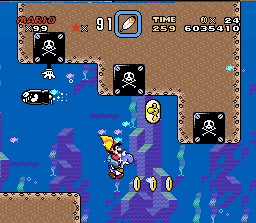
This is the challenge which comes closest to the preservation of momentum theme, as the player needs to use smooth, quick motions to steer Mario through the launchers and above the Blurps before the two waves of intercepts start colliding.
The fifth challenge both expands and evolves upon the third challenge, and requires the player to make very quick calculations about how to proceed. Here we see the launchers placed in the middle of the path, and in this case on both sides of Mario.
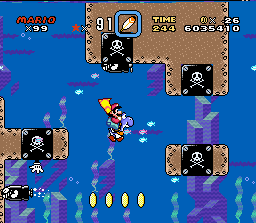
It�s tempting for the player to try and swing all the way down before the second set of launchers starts firing, but it�s probably too difficult for the unprepared because of the aggro radius of those launchers. This is where the player will be forced to summon back up their periodic enemies skills and wait�although it�s a little trickier in water. By pausing before entering the middle of these launchers, it�s possible for Mario to syncopate their firing cycles. With only two torpedoes threatening at a time, it�s much easier to time Mario�s exit.
The sixth challenge takes the basic idea of the fourth challenge�s widely-spaced launchers and reiterates the evolution from challenges three and five, splitting them up. It also adds a new and obvious wave of intercepts as a wave of parallel Blurps that crosses the screen.
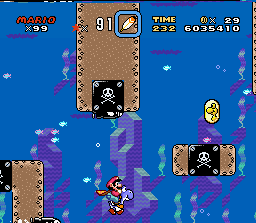
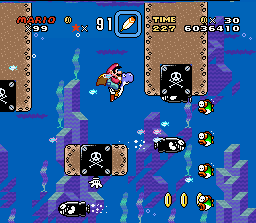
This challenge isn�t especially hard, because the intercepts make it clear to the player how Mario is supposed to travel. That wall of Blurps makes it especially clear that Mario is supposed to wait, and since the decision has already been made, the player can spend the waiting period figuring out the timing of the torpedo launchers. Really, this challenge could have come much earlier in the level, because it makes it clear what kind of strategies are going to work the best here�strategies for the periodic enemies theme. Because the Torpedo Teds look so much like intercepts, some (perhaps numerically reduced) form of this would have cued the player�s instincts properly. With that in mind, this is an advanced level and so some surprises and complex challenges are expected. This level also gives more evidence that the designers weren�t consciously planning skill themes. The themes were probably only visible after the fact, and so there was no reason for this level to adhere to any one of them.
The final challenge is a simple expansion-by-contraction upon challenge four: the launchers get closer together and the aperture Mario swims through gets narrower. It�s technically possible to squeeze through before the last launcher starts firing by executing a perfect swimming maneuver with perfect placement, but it�s easier to just duck:
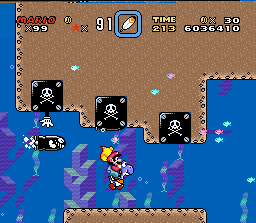
This is as good an example of the periodic enemies theme as any in the game; the slowing effect of the water only makes the stop/go action more pronounced.
VALLEY FORTRESS
Valley Fortress represents the culmination of the periodic enemies theme, and in my judgment this is possibly the best level in the game from a player�s standpoint. From a design analysis standpoint this level is technically excellent in a formulaic way, but otherwise unremarkable. There�s a lesson in that; Tubular is surprising, inventive, exotic, and generally terrible. Valley Fortress is staid and numerically by-the-book, but still very enjoyable. The lesson, to distill it to its essence, is that if you have good mechanics and a good organizational system for implementing them, you don�t need anything more. Now, those things need to be implemented correctly in more than one way. Vanilla Dome 3 is an example of an elegant, technically great level that suffers because it�s too slow and too easy. Soda Lake is also an elegant level, but it tries to surprise by doing something unusual, and ends up alienating a lot of new players who find it unfair. Valley Fortress does everything right by simply executing a straightforward, intuitive cadence with just the right amount of everything.
This is the standard challenge (left), which simply reintroduces the smashing spiked pylon in a context that is otherwise penalty-free. One very minor unusual thing here is the stair-like descent of the platforms during this standard challenge. The purpose of this, if it was intentional, is to help establish a frame of reference for the player for how much distance Mario can cross during one cycle of the pylons. The length of each platform is obvious because of the way they�re staggered, and the speed of the pylons is obvious too.
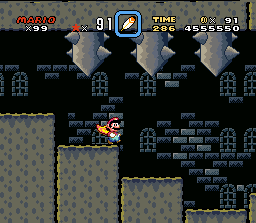
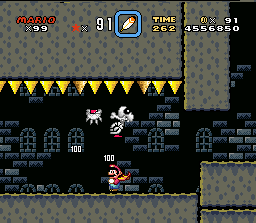
After the standard, the level bounces over from periodic enemies to a kind of non-thematic action section. The level features several of these, in fact. They�re not quite crossovers; indeed, many of them are still in the periodic enemies theme but are different enough that they punctuate the cadence progression. This challenge breaks up the pylon cadence later in the level.
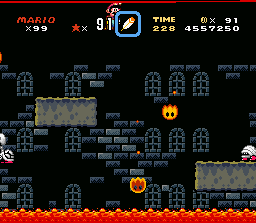
These fireballs are definitely periodic enemies because they fire far enough ahead of Mario that the player can simply time them. The point, however, is that these are different enough from the pylons to cleanse the player�s palate, but short enough that they don�t bog the level down.
The expansions and evolution in this level are glaringly straightforward, and yet this doesn�t hurt them at all. For example, the first evolution and evolution expansion contain obvious changes to the standard theme. The gaps between the smashing spike pylons disappear and are replaced by spike pits.
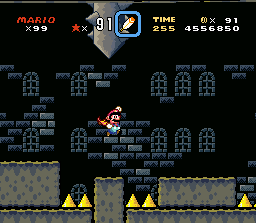
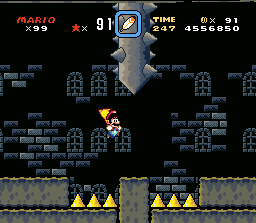
The first challenge actually drops the number of pylons from the standard (which had sets of 3 pylons in a row), but evolves the challenge by adding two spike pits. This challenge then repeats with an expanded d-distance, a simple expansion upon the evolution.
The next challenge brings the difficulty level back up to the standard number of pylons, but maintains the evolved form, making for what we might call a �part A� pinnacle. After this challenge, the level throws in one of its semi-crossover palate cleansers (right).
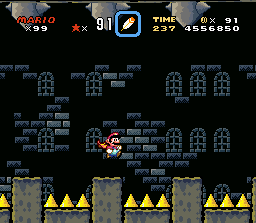
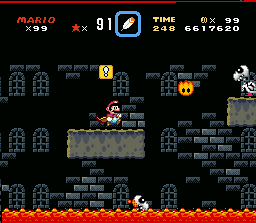
This crossover actually sets up the next section, which brings us another very straightforward evolution. From this point onwards�what we might call the b-section of the level�the smashing pylons are going to operate at double speed. It�s an obvious expansion, simply increasing one variable, and yet it�s going to make a huge difference.
The b-section of the level, featuring the double-speed pylons, is actually quite short and straightforward as well. The first challenge drops the number of pylons down to one so that the player can get accustomed to the new speed with an easier challenge, but notice that the new section not only doubles the speed of pylons but also increases the penalty to 2 with the lava below, and brings back the fireball.
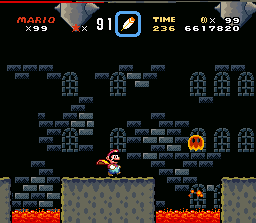
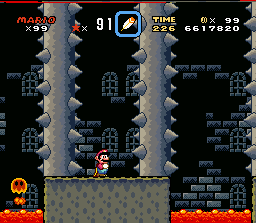
The next island evolves this in an obvious way, by adding a pylon, but drops the fireball. Of course, the reason it drops the fireball is only to bring it back for the pinnacle challenge, below. Notice that the pinnacle challenge also has a shorter platform, although this is purely psychological. From a momentum perspective, there�s no difference between three and five blocks in a starting platform. It does give the player a cramped feeling, though.
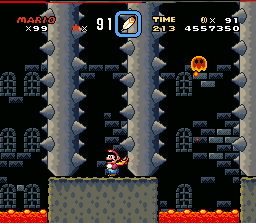
Leaping from a two-pylon platform to another two-pylon platform also has a hidden danger: the effective d-distance of the jump is actually extended by the width of the pylon on the landing platform. Mario can�t really stand there for more than the most fleeting second, so really this looks like a 5-block jump when it acts like a 7-block jump. Certainly, that can take a player by surprise and make the jump more intimidating the second or third times through.
Last, I�d like to mention this denouement challenge:
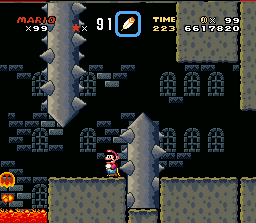
This challenge is actually very easy, if the player times it, and it even helps to explain the rest of the level. This level, like all levels in the periodic enemies theme, is about timing. In this case, Mario has to do a bit more jumping than is normal for a periodic enemies level, but the emphasis on timing has never been greater. What this last challenge points out is that the player has to anticipate the movement of the spiked pylon to the point that he starts moving before the pylon in front of Mario retracts. The opposing pylons at the end here visualize this more clearly than the challenges that have come before. This visualization works as the perfect denouement to the rest of the level precisely because it�s so obvious. If the player was simply going by instinct and intuition, this easier, explanatory challenge serves perfectly to make it clear what this level was all about. Placed where it is, this last challenge also cuts the tension before a fight with the comparatively easy Reznors; it would be a shame to beat one of the hardest levels in the game only to lose during the easy part.